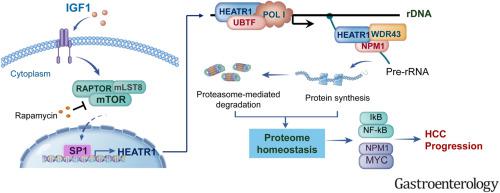Gastroenterology ( IF 25.7 ) Pub Date : 2023-05-27 , DOI: 10.1053/j.gastro.2023.05.029 Xiao-Mei Yang 1 , Xiao-Qi Wang 1 , Li-Peng Hu 1 , Ming-Xuan Feng 2 , Yao-Qi Zhou 1 , Dong-Xue Li 1 , Jun Li 1 , Xiao-Cao Miao 1 , Yan-Li Zhang 1 , Lin-Li Yao 1 , Hui-Zhen Nie 1 , Shan Huang 1 , Qiang Xia 2 , Xue-Li Zhang 1 , Shu-Heng Jiang 1 , Zhi-Gang Zhang 1

|
Background & Aims
Hyperactivation of ribosome biogenesis leads to hepatocyte transformation and plays pivotal roles in hepatocellular carcinoma (HCC) development. We aimed to identify critical ribosome biogenesis proteins that are overexpressed and crucial in HCC progression.
Methods
HEAT repeat containing 1 (HEATR1) expression and clinical correlations were analyzed using The Cancer Genome Atlas and Gene Expression Omnibus databases and further evaluated by immunohistochemical analysis of an HCC tissue microarray. Gene expression was knocked down by small interfering RNA. HEATR1-knockdown cells were subjected to viability, cell cycle, and apoptosis assays and used to establish subcutaneous and orthotopic tumor models. Chromatin immunoprecipitation and quantitative polymerase chain reaction were performed to detect the association of candidate proteins with specific DNA sequences. Endogenous coimmunoprecipitation combined with mass spectrometry was used to identify protein interactions. We performed immunoblot and immunofluorescence assays to detect and localize proteins in cells. The nucleolus ultrastructure was detected by transmission electron microscopy. Click-iT (Thermo Fisher Scientific) RNA imaging and puromycin incorporation assays were used to measure nascent ribosomal RNA and protein synthesis, respectively. Proteasome activity, 20S proteasome foci formation, and protein stability were evaluated in HEATR1-knockdown HCC cells.
Results
HEATR1 was the most up-regulated gene in a set of ribosome biogenesis mediators in HCC samples. High expression of HEATR1 was associated with poor survival and malignant clinicopathologic features in patients with HCC and contributed to HCC growth in vitro and in vivo. HEATR1 expression was regulated by the transcription factor specificity protein 1, which can be activated by insulin-like growth factor 1–mammalian target of rapamycin complex 1 signaling in HCC cells. HEATR1 localized predominantly in the nucleolus, bound to ribosomal DNA, and was associated with RNA polymerase I transcription/processing factors. Knockdown of HEATR1 disrupted ribosomal RNA biogenesis and impaired nascent protein synthesis, leading to reduced cytoplasmic proteasome activity and inhibitory-κB/nuclear factor-κB signaling. Moreover, HEATR1 knockdown induced nucleolar stress with increased nuclear proteasome activity and inactivation of the nucleophosmin 1-MYC axis.
Conclusions
Our study revealed that HEATR1 is up-regulated by insulin-like growth factor 1–mammalian target of rapamycin complex 1–specificity protein 1 signaling in HCC and functions as a crucial regulator of ribosome biogenesis and proteome homeostasis to promote HCC development.
中文翻译:

含有 1 的核仁 HEAT 重复序列通过雷帕霉素复合物 1 信号传导的机制靶标上调,通过控制核糖体生物发生和蛋白质组稳态来促进肝细胞癌生长
背景与目标
核糖体生物发生的过度激活会导致肝细胞转化,并在肝细胞癌(HCC)的发展中发挥关键作用。我们的目的是鉴定在 HCC 进展中过度表达且至关重要的关键核糖体生物发生蛋白。
方法
使用癌症基因组图谱和基因表达综合数据库分析 HEAT 重复序列 1 (HEATR1) 表达和临床相关性,并通过 HCC 组织微阵列的免疫组织化学分析进一步评估。基因表达被小干扰 RNA 抑制。对HEATR1敲低细胞进行活力、细胞周期和细胞凋亡测定,并用于建立皮下和原位肿瘤模型。染色质免疫沉淀和定量聚合酶链反应用于检测候选蛋白与特定DNA序列的关联。内源免疫共沉淀结合质谱用于鉴定蛋白质相互作用。我们进行了免疫印迹和免疫荧光测定来检测和定位细胞中的蛋白质。透射电镜检测核仁超微结构。Click-iT (Thermo Fisher Scientific) RNA 成像和嘌呤霉素掺入测定分别用于测量新生核糖体 RNA和蛋白质合成。在HEATR1敲低 HCC 细胞中评估了蛋白酶体活性、20S 蛋白酶体病灶形成和蛋白质稳定性。
结果
HEATR1是 HCC 样本中一组核糖体生物发生介质中上调程度最高的基因。HEATR1 的高表达与HCC患者的不良生存率和恶性临床病理特征相关,并促进 HCC 的体外和体内生长。HEATR1 表达受转录因子特异性蛋白 1 调节,该蛋白可被 HCC 细胞中雷帕霉素复合物 1 信号转导的胰岛素样生长因子 1(哺乳动物靶标)激活。HEATR1 主要定位于核仁,与核糖体 DNA 结合,并与RNA 聚合酶 I 转录/加工因子相关。HEATR1的敲低会扰乱核糖体 RNA 生物发生并损害新生蛋白质合成,导致细胞质蛋白酶体活性和抑制性 κB/核因子 κB 信号传导降低。此外,HEATR1敲低会诱导核仁应激,导致核蛋白酶体活性增加和核磷蛋白 1-MYC 轴失活。
结论
我们的研究表明,HEATR1 在 HCC 中受到胰岛素样生长因子 1(雷帕霉素复合物 1 的哺乳动物靶点)特异性蛋白 1 信号传导的上调,并作为核糖体生物合成和蛋白质组稳态的关键调节因子,促进 HCC 的发展。











































 京公网安备 11010802027423号
京公网安备 11010802027423号